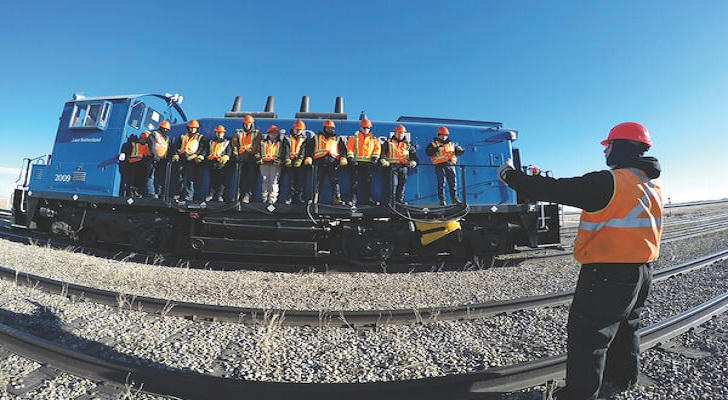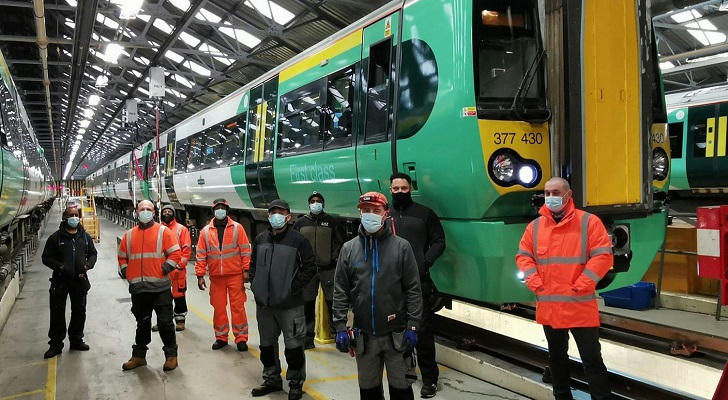Government-Supported Railway Maintenance Technician Training: A High-Paying, Hands-On Career
The railway industry plays a crucial role in national and global transportation, offering high-paying and stable careers for skilled maintenance technicians. With government-supported training programs, aspiring railway maintenance professionals can develop hands-on technical skills while earning a salary, entering the workforce quickly without accumulating significant student debt.

🚄 High Salary and Job Stability in the Railway Industry
The railway industry is known for its stable and well-compensated careers. According to the U.S. Bureau of Labor Statistics (BLS), the median annual wage for railway maintenance technicians ranges from $50,000 to $80,000, with senior-level professionals earning even more.
Unionized Industry: Many railway jobs are part of strong labor unions, ensuring stable employment, healthcare benefits, retirement plans, and paid time off.
Job Security: With the aging railway infrastructure and increasing reliance on rail transport, the demand for maintenance technicians is projected to grow steadily over the next decade.
Opportunities for Advancement: Through certification and experience, technicians can move into roles such as railway engineers, maintenance supervisors, and infrastructure specialists, further increasing their earning potential.
🔧 Hands-On Learning with Strong Technical Foundations
Railway maintenance training programs emphasize practical, skills-based learning, making them ideal for individuals interested in mechanical, electrical, and engineering fields.
Core Training Topics:
Track Maintenance: Repairing and inspecting railway tracks for safety and durability.
Locomotive & Carriage Inspection: Learning diagnostics and repair techniques for engines and passenger cars.
Electrical & Signal Systems: Maintaining railway signals, communication networks, and automated control systems.
Safety Regulations & Compliance: Understanding and implementing Federal Railroad Administration (FRA) safety standards.
Many programs partner with railway companies to provide internships and hands-on training, allowing students to apply their knowledge in real-world settings while gaining valuable experience.

🚆 High Demand for Railway Maintenance Technicians
The U.S. railway infrastructure is aging, and with the increasing demand for freight and passenger rail transport, the need for maintenance professionals continues to rise.
The Association of American Railroads (AAR) reports that the U.S. freight rail industry invests over $25 billion annually in infrastructure maintenance and upgrades, driving demand for skilled technicians.
The expansion of high-speed rail (HSR) and urban light rail projects requires additional maintenance personnel, creating new job openings in cities across the country.
Retirement rates among current railway workers are high, leading to thousands of job vacancies in the coming years.
⏳ Short Training Programs for Quick Employment
Unlike traditional four-year college degrees, railway maintenance training programs are designed to get students into the workforce quickly.
Many certificate programs take only 3-6 weeks, while more advanced diploma or associate degree programs take 6-12 months.
Some technical colleges offer job placement assistance, ensuring students transition directly into employment upon graduation.
Tuition costs for railway maintenance programs are significantly lower than university degrees, with some government-backed programs offering low-cost training.
🏫 Flexible Learning Options: Online & Hands-On Training
Railway maintenance training programs cater to diverse learning needs, offering blended learning approaches combining online coursework with hands-on practical experience.
Hybrid Learning: Students can complete theory-based modules online while participating in in-person workshops and field training sessions.
Paid Apprenticeships: Some railway companies provide on-the-job training with salaries, allowing students to earn income while learning.
Government-Funded Initiatives: Programs supported by the Federal Railroad Administration (FRA) and Department of Labor provide tuition assistance, reducing the financial burden on students.
🏆 Industry-Recognized Certifications & Career Growth
To enhance employability, students can pursue nationally recognized certifications from organizations such as the National Railroad Construction & Maintenance Association (NRCMA) and the Federal Railroad Administration (FRA).
Certification programs validate skills in railway safety, inspection techniques, and mechanical maintenance, making graduates more competitive in the job market.
Career advancement opportunities include roles such as railway maintenance supervisors, track engineers, and rolling stock specialists, with salaries exceeding $90,000 annually.
💰 Salary Expectations & Career Progression
Railway maintenance technicians enjoy competitive salaries with growth potential based on experience and specialization.
| Experience Level | Monthly Salary | Annual Salary |
|---|---|---|
| Entry-Level (0-5 years) | $4,000 - $5,500 | $48,000 - $66,000 |
| Mid-Career (5-15 years) | $6,000 - $7,500 | $72,000 - $90,000 |
| Senior-Level (15+ years) | $8,000 - $10,000 | $96,000 - $120,000 |
🎓 How to Enroll in a Railway Maintenance Program
Starting a career in railway maintenance is straightforward. Follow these steps to apply for a training program:
📝 Submit an Application: Most programs require an online or in-person application with basic educational qualifications.
📄 Provide Proof of Education: High school diploma, GED, or equivalent certification is typically required.
🔧 Complete an Entrance Exam (if applicable): Some programs require basic mechanical or mathematical assessments.
💼 Apply for Apprenticeships: Many programs partner with railway companies to offer paid training opportunities.
📜 Earn Your Certification: Successfully complete coursework and practical training to receive industry-recognized credentials.

🌟 Success Story: From Student to Railway Engineer
Michael, a 27-year-old technician, started his career with a 6-week railway maintenance certificate program. Within two years, he advanced to a lead maintenance role, earning over $80,000 annually.
“This program gave me hands-on skills, job security, and a great salary. I’m now working toward becoming a railway engineer.”
Michael’s story reflects a common path for many in the railway industry—starting with entry-level maintenance work and advancing into high-paying, specialized positions.
🚀 Start Your Railway Maintenance Career Today!
Railway maintenance offers a stable, well-paid, and in-demand career for those who enjoy hands-on technical work. With government-supported training programs, students can enter the field quickly and affordably.
👉 Take the first step toward a rewarding career—apply today!
For more information on available training programs, visit Railway Training & Education.
